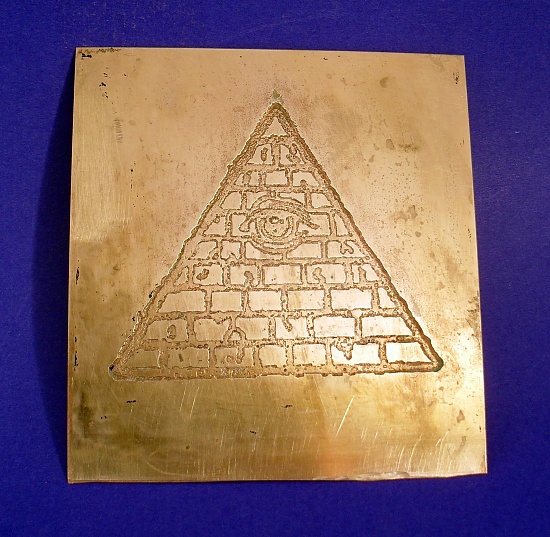
This is an etching on a thin sheet of brass done almost entirely with things found around the house. I adapted the basic technique from some pages at the terribly interesting Steampunk Workshop.
The metal is 0.015" brass I got at the local hobby supply store. It had no protective coatings requiring special cleaning, so it was pretty much ready to use out of the box. My first experiments were with even thinner metal, essentially thick brass foil. OK for some proof of concept, but not nearly durable enough to stand up to any punishment. First important lesson: use metal you can't easily bend with two fingers.
A few minutes work with any good image manipulation program can turn just about any black-and-white image (or any image which looks OK converted into black and white; but it has to be B&W, not greyscale) into something suitable for ironing onto the work piece. Because I only wanted etching on the front, I covered the back with packing tape. A coat of spray polyurethane would have worked just as well, but might have been annoying to scrape off down the line if I decided to etch the other side. The weird part here is that when I got the paper peeled and rubbed off of the toner, the residue turned white when it dried. Still, it stuck to the metal admirably. (Oh, second important lesson: glossy injket paper through a laser printer. Regular paper doesn't work.)
An old laptop power adapter provided the power source. The plug for the computer end had become uselessly frayed. I simply cut it off and stripped the cable down to separate the positive and negative wires. The inner wire attaches to the work piece, the outer wire to something that sticks into the etching solution.
Speaking of which, I used salt water for the etching solution rather than more expensive, more toxic, and more not-in-my-house-that-day copper sulphate. The size and shape of the piece allowed me to use a gallon milk jug with the top cut off. Once it went in the saline and the power was plugged in, it started bubbling away, and the solution became tinged noticeably blue after an hour or so. Third important lesson: it takes a long time to etch. This piece took about eight hours. Fortunately, I'm in no hurry.
After drying it off, I tried a number of things to clean off the corroded bits of exposed brass and the toner. The wire brush attachment on my Dremmel tool was marvelous, but it pretty much destroyed the brush. Sandpaper...just don't. The winner is, as the Steampunk Workshop suggests, steel wool and a lot of vigorous scrubbing.
No comments:
Post a Comment